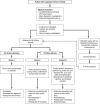Chronic Tinnitus
- PMID: 35197187
- PMCID: PMC9342131
- DOI: 10.3238/arztebl.m2022.0135
Chronic Tinnitus
Abstract
Background: Chronic tinnitus is a commonly occurring symptom of the auditory system. Epidemiological studies assume a lifetime prevalence in men and women of 3.5% for chronic tinnitus requiring treatment. Almost 25% of all Germans have experienced at least one episode of tinnitus. No causal therapy is yet available, but numerous treatment strategies are being pursued. Rigorous scientific assessment of these procedures is essential.
Methods: For this exhaustive revision of the German clinical practice guideline, the literature in the medical databases PubMed and Cochrane Library, including existing guidelines from various countries, was systematically searched using keywords on the topic of chronic tinnitus. On the basis of the revised guideline, a separate guideline was written in language accessible to patients.
Results: Chronic tinnitus is often associated with hearing loss, but the mental distress caused by the ear noise is another crucial element. Apart from expert counseling, the recommended treatment comprises psychotherapeutic interventions, particularly cognitive behavioral therapy (with effect sizes of 0.54 to 0.91 for reduction of the tinnitus-related distress), and measures to improve the hearing. There is insufficient evidence regarding the effects of drug treatment, sound and music therapy, and neuromodulation (magnetic stimulation or electrostimulation).
Conclusion: Alongside thorough and sound diagnosis and counseling, the principal treatment options for chronic tinnitus are specific cognitive behavioral therapy and expert psychotherapeutic interventions on an individual or group basis. Future-preferably interdisciplinary-research should evaluate the long-term effects of the treatment options, with particular attention to psychosomatic comorbidity.
Figures
Comment in
-
In Reply.Dtsch Arztebl Int. 2022 Oct 7;119(40):683-684. doi: 10.3238/arztebl.m2022.0234. Dtsch Arztebl Int. 2022. PMID: 36594340 Free PMC article. No abstract available.
References
-
- Pilgramm M, Rychlik R, Lebisch H, Siedentop H, Goebel G, Kirchhoff D. Tinnitus in der Bundesrepublik Deutschland - eine repräsentative epidemiologische Studie. HNO aktuell. 1999;7:26–25.
-
- McCormack A, Edmondson-Jones M, Somerset S, Hall D. A systematic review of the reporting of tinnitus prevalence and severity. Hear Res. 2016;337:70–79. - PubMed
-
- Biesinger E, Heiden C, Greimel V, Lendle T, Höing R, Albegger K. Strategien in der ambulanten Behandlung des Tinnitus. HNO. 1998;46 15769. - PubMed
-
- Zirke N, Seydel C, Szczepek A, Olze H, Haupt H, Mazurek B. Psychological comorbidity in patients with chronic tinnitus: analysis and comparison with chronic pain, asthma or atopic dermatitis patients. Qual Life Res. 2013;22:263–272. - PubMed
Publication types
MeSH terms
LinkOut - more resources
Full Text Sources
Medical


